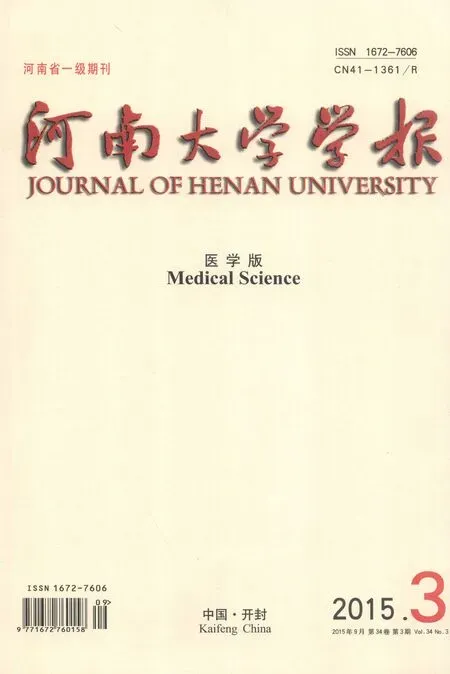三阴性乳腺癌中nm23-H1及P53与VEGF的研究进展
江 飞,周 芳,李 彬,孙少林
(开封市妇产医院, 河南 开封 475000)
三阴性乳腺癌中nm23-H1及P53与VEGF的研究进展
江飞,周芳,李彬,孙少林
(开封市妇产医院, 河南 开封 475000)
摘要:目的探讨年轻女性中抑癌基因与癌基因如nm23-H1、P53、VEGF在三阴性乳腺癌的生成、转移及复发的作用。方法通过资料查阅详细阐述nm23-H1、P53、VEGF的结构及信号转导通路与恶性肿瘤的关系。结果三阴性乳腺癌发生、发展以及预后与nm23-H1、P53、VEGF的结构及信号通路有一定的相关性。结论nm23-H1、P53、VEGF可能是治疗三阴性乳腺癌的靶点和方向。
关键词:nm23-H1;P53;VEGF; 三阴性乳腺癌
乳腺癌已成为危害全世界妇女健康的恶性肿瘤之一,乳腺癌是一种高度异质性和生物学特性,多样化的恶性肿瘤细胞。全世界每年有100万女性患者被确诊为乳腺癌。在我国乳腺恶性肿瘤同样是威胁广大女性生命的主要恶性肿瘤之一。乳腺癌患者中大约近1/3死于癌灶的转移及复发。有资料提及2000年上海市乳腺癌发病率达28.8/10万,北京市达35.1/10万[1]。2000年美国斯坦福大学Perou和sorlie等[2-4]通过基因芯片的成熟的运用把乳腺癌分子分型为4型LuminalA(ER或PR+ Her2- KI67<14%)、LuminalB(ER或PR+/-Her2+ KI67>14%)、Hre2过表达性、Basal-like(ER PR Her2均-)。三阴性乳腺癌(triple negative breast cancer TNBC)提示(estrogen receptor ER)、(progesterone receptor PR)、(humanepidermal growth factor receptor-2 Her2)均为阴性,三阴性乳腺癌(TNBC)的特点是雌激素受体(ER)、孕激素受体缺失(PR),以及人类表皮生长因子受体-2(HER2)[5]。TNBC约占所有乳腺癌亚型的15%,是乳腺癌的一种特殊亚型[6]。目前,只有传统的化疗方案是唯一的手术后的治疗手段[7]。三阴性乳腺癌治疗的难点是在于缺乏特异的靶点,内分泌治疗难以获益,抑制肿瘤血管生成是一个很有前景的治疗策略。
1nm23-H1的结构和功能
nm23基因作为一个肿瘤转移抑制基因在1988年被施泰格等人发现[8]。BevilacquHartsough MT等[9]人,描述人类nm23基因,位于细胞的包膜或胞浆内。被发现在良性和恶性组织中的表达。nm23的一个特点是其可以抑制各种化学活动的活性。nm23能显著的抑制多个转移模型系统[10]。在8个已知的亚型里nm23-H1基因的抗肿瘤转移抑制因子与人类癌症相关,更重要的是,越来越多的工作,明确提出了关键作用nm23-H1具有多种生物学功能,包括转录调控、分化、增殖,最重要的是抑制肿瘤转移。
2nm23-H1与肿瘤的关系
乳腺癌患者主要的死亡原因是转移性疾病和其治疗的并发症。转移抑制基因提供了肿瘤转移分子调控的新见解。在8个已知的亚型里nm23-H1基因的抗肿瘤转移抑制因子与人类癌症相关,更重要的是,越来越多的工作,明确提出了关键作用nm23-H1具有多种生物学功能,包括转录调控、分化、增殖,最重要的是抑制肿瘤转移。转移抑制基因nm23-H1蛋白的超表达虽然对原发肿瘤体积无影响,但能显著减少转移的形成[11]。在体外,nm23-H1一个特点是它的运动对多种趋化因子的抑制,在多模型系统里nm23-H1基因超表达转染显著抑制肿瘤转移[12]。一项临床动物实验提示提取nm23-H1沉淀蛋白注入患恶性肿瘤载体的小鼠体内形成nm23-H1超表达,10周后观察小鼠内脏肝、肺转移病灶数目显著减少,因此得出的结论nm23-H1超表达的能动性和转移抑制基因的典型特征基因[13]。
虽然nm23-H1对于乳腺患者的年龄、病灶的大小、组织学分级、TNM分期无明显的关联性,但是国外很多研究证实nm23-H1转移抑制基因抗体对于乳腺恶性肿瘤引起的转移病灶呈压制作用,所以nm23-H1可以作为一个预测原发病灶远处转移的一个检测手段,同时也是治疗恶性肿瘤病灶远处转移的一个靶点。
3P53的结构和功能
P53基因是一个抑癌蛋白质,被称为“守护的基因组”,P53肿瘤抑制基因存在于17p,编码一个393个氨基酸的核磷酸化蛋白。位于细胞的细胞核内,因其诱导衰老的能力,细胞周期逮捕,或细胞凋亡时,细胞暴露于各种形式的能力,包括DNA损伤。因此,功能性P53的损失,这使得细胞无法进行细胞凋亡或衰老,有助于肿瘤的形成。事实上P53基因突变与预后不良相关在许多人类肿瘤,包括乳腺癌。
在正常乳腺组织中P53的表达很低或者无法衡量的,人们普遍认为在正常组织中P53蛋白存在于如此之低,这些数量是不容易被免疫化学技术所发现的,因此,P53蛋白在正常乳腺上皮细胞的积累是一个极不寻常的发现,因为异常稳定的P53蛋白只与恶性肿瘤和DNA损伤有关[14]
4P53与肿瘤的关系
P53突变在间叶细胞过渡过程中发挥作用,通过抑制上皮标记如钙黏蛋白[15],P53高表达及Ki67高表达和组织学评分相关,而肿瘤直径越大和VEGF(血管内皮生长因子)、EGFR(表皮生长因子)及Ⅱ型拓扑异构酶相关[16]。 P53基因已被描述为在乳腺癌里最易突变的基因,约有30%的肿瘤都会有P53突变[17]。有很多研究显示,P53基因突变和乳腺癌预后差有密切的相关性[18],肿瘤的显微研究表明,P53突变可以使导管原位癌(DCIS)发展到浸润性乳腺癌,频率增加从低级别的DCIS 10%发展到30%~40%高级别的DCIS。P53的表达与Ki67、肿瘤直径大小、高组织学级别及VEGF有很大的关联性。在肿瘤中P53蛋白表达丢失,导致细胞无法进行细胞凋亡或衰老,有助于肿瘤的形成。除了影响细胞凋亡和细胞衰老,P53的损失已被证明影响细胞运动的一种方式,可以促进肿瘤的侵袭和转移潜能。P53基因突变通常存在与组织学级别比较高的乳腺恶性肿瘤里面,这往往提示这一类患者预后不良,有远处转移的迹象。研究显示P53的表达被证明与肿瘤分级、核异型性、间质增生、有丝分裂率、间质核的多形性和浸润性肿瘤边缘相关。P53基因突变是在许多肿瘤中常见的发生与肿瘤进展相关,化疗耐药,预后差。P53的突变或表达可以积极影响肿瘤细胞的转移潜力,了解P53损失和突变的机制对了解促进肿瘤转移肿瘤的生物学发展至关重要,这是一个治疗靶点的研究方向。
5结语
三阴性乳腺癌(TNBC)是乳腺癌(BC)的一种亚型,它被定义为雌激素受体(ER),孕激素受体(PR)和人表皮生长因子受体(HER2)均为阴性。它的起源和发展似乎是难以捉摸的,由于其3~5年的局部复发率以及内脏转移率高,预后差,生存期短,对TNBC的研究还需要很多研究去探索,本文通过采取对nm23-H1、P53、VEGF的结构及信号通路与肿瘤的关系,来阐述与三阴性乳腺癌发生、发展以及预后有一定的相关性,也预测上述三者可能是治疗三阴性乳腺癌的靶点和方向。
参考文献:
[1] 王润华,曾 军,邓 丹.乳腺癌流行病学调查危险因素集合的地域特征[J].重庆医学,2003,32(3):259-260.
[2] Perou C M, Sorlie T, Eisen M B, et a1. Molecular portraits of human breast tumours[J].Nature,2000,406(6 797):747-752.
[3] Sorlie T, Perou C M, Tibshirani R,et a1. Gene expression patterns of breastcarcinomas distinguish tumor subclasses with dinical implications[J].Proc Natl Acad Sci,2001, 98(19):10 869-10 874.
[4] Sorlie T,Tibshirani R, Parker J, et a1. Repeated observation of breast turnout subtypes in independent gene ex-pression data sets[J]. Proc Natl Acad Sci, 2003, 100(14): 8 418-8 423.
[5] Bosch A, Eroles P, Zaragoza R, et al. Triple-negative breast cancer: molecular features, pathogenesis, treatment and current lines of research [J]. Cancer Treat Rev,2010, 36(3): 206-215.
[6] Rakha E A, Elsheikh S E, Aleskandarany M A, et al. Triple-negative breast cancer:distinguishing between basal and nonbasal subtypes [J]. Clin Cancer Res,2009, 15(7): 2 302-2 310.
[7] Bae Y H, Ryu J H, Park H J,et al. Mutant p53-Notch1 signaling axis is involved in curcumin-induced apoptosis of breast cancer cells [J]. Korean J Physiol Pharmacol,2013, 17(4): 291-297.
[8] Soady K J, Kendrick H, Gao Q,et al.Mouse mammary stem cells express prognostic markers for triple-negative breast cancer[J]. Breast Cancer Res,2015, 17(1): 31.
[9] Liedtke C, Mazouni C, Hess K R. Response to neoadjuvant therapy and long-term survival in patients with triple-negative breast cancer [J]. Clin Oncol,2008 , 26(8): 1 275-1 281.
[10] Steeg P S, Bevilacqua G, Kopper L,et al. Evidence for a novel gene associated with low tumor metastatic potential [J]. Natl Cancer Inst, 1988, 80(3): 200-204.
[11] Hartsough M T, Steeg P S.Nm23/nucleoside diphosphate kinase in human cancers [J]. Bioenerg Biomembr, 2000, 32(3): 301-308.
[12] Saha A, Robertson E S.Functional modulation of the metastatic suppressor Nm23-H1 by oncogenic viruses[J]. FEBS Lett, 2011, 585(20): 3 174-3 184.
[13] Qingbei Zhang, J R McCorkle,Marian Novak,et al.Metastasis suppressor function of NM23-H1 requires its 3’-5’exonuclease activity [J]Cancer,2011,128(1): 40-50.
[14] Rinker-Schaeffer C W, O'Keefe J P, Welch D R,et al. Metastasis suppressor proteins: discovery, molecular mechanisms, and clinical application[J]. Clin Cancer Res, 2006, 12(13): 3 882-3 889.
[15] Marino N, Nakayama J, Collins JW,et al.Insights into the biology and prevention of tumor metastasis provided by the Nm23 metastasis suppressor gene [J]. Cancer Metastasis Rev,2012, 31(3/4): 593-603.
[16] Marino N, Marshall J C, Collins J W,et al.Nm23-h1 binds to gelsolin and inactivates its actin-severing capacity to promote tumor cell motility and metastasis[J]. Cancer Res, 2013, 73(19): 5 949-5 962.
[17] Miliĉeviĉ Z, Bajiĉ V, zvkoviĉ L,et al.Identification of p53 and its isoforms in human breast carcinoma cells[J]. Scientific World Journal, 2014,201(4): 618-698.
[18] Roger L, Jullien L, Gire V, et al. Gain of oncogenic function of p53 mutants regulates E-cadherin expression uncoupled from cell invasion in colon cancer cells[J]. Cell Sci 2010, 123(8): 1 295-1 305.
[责任编辑李麦产]
The research about the relation between triple negative breast cancer and nm23-H1 and P53 and VEGF
JIANG Fei, ZHOU Fang, LI Bin, SUN Shaolin
(WomenandInfantsHospitalofKaifeng,Kaifeng,Henan475000,China)
Abstract:ObjectiveExplore the relationship between young women’s tumor suppressor gene and oncogene like nm23-H1, P53, VEGF in the generation, transfer and relapse of Triple Negative Breast Cancer (TNBC). MethodsElaboration of the relationship between the structure and signal transduction pathway of nm23-H1, P53, VEGF and malignant tumor. ResultsThe generation, development and prognosis of Triple Negative Breast Cancer have certain relevance to the structure and signal transduction pathway of nm23-H1, P53, VEGF. Conclusion It may be predicted that the aforementioned three would be the therapeutic target and direction in curing Triple Negative Breast Cancer.
Key words:nm23-H1; P53; VEGF; triple negative breast cancer
作者简介:江飞(1975-),男,河南开封市人,硕士,主治医师,从事乳腺外科疾病的诊治工作。
基金项目:开封市科技攻关项目(140124)。
收稿日期:2015-06-02
文章编号:1672-7606(2015)03-0226-03
中图分类号:R711
文献标识码:A

